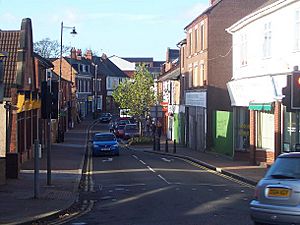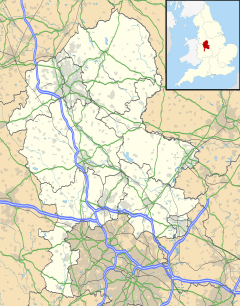Hednesford facts for kids
Quick facts for kids Hednesford |
|
|---|---|
 Market Street, Hednesford |
|
| Population | 18,718 (2021 Census) |
| OS grid reference | SK000126 |
| District |
|
| Shire county | |
| Region | |
| Country | England |
| Sovereign state | United Kingdom |
| Post town | CANNOCK |
| Postcode district | WS12 |
| Dialling code | 01543 |
| Police | Staffordshire |
| Fire | Staffordshire |
| Ambulance | West Midlands |
| EU Parliament | West Midlands |
| UK Parliament |
|
Hednesford is a lively market town in Staffordshire, England. It's located in the Cannock Chase district, with the beautiful Cannock Chase area of natural beauty just north of the town. Hednesford is about 1 mile (1.6 km) north of Cannock and 5 miles (8 km) south of Rugeley. In 2011, about 17,343 people lived here.
Contents
- What's in a Name? The History of Hednesford's Name
- Hednesford's Past: A Journey Through Time
- How Hednesford is Governed
- Exploring Hednesford's Geography
- Hednesford's Economy: How People Work and Live
- Important Places and Landmarks in Hednesford
- Getting Around: Transport in Hednesford
- Media: News and Entertainment
- Education: Schools in Hednesford
- Sports and Fun in Hednesford
- Famous People from Hednesford
- Images for kids
What's in a Name? The History of Hednesford's Name
Hednesford was first mentioned in records way back in 1153. Back then, it was called Hedenedford. Over hundreds of years, the name slowly changed. People wrote it down in different ways like Ed(e)nesford, Adnesford, and Hedg(e)ford.
The name probably means "The ford of Heddīn". A ford is a shallow place in a river or stream where you can cross. Heddīn was an old English nickname for someone named Headda.
Hednesford's Past: A Journey Through Time
The first time Hednesford was written about was in 1153. King Stephen said that the small village of Hedenedford didn't have to pay certain taxes related to pigs.
You can see Hednesford on an old map from 1775 by William Yates. It shows the town as a tiny village with only 13 buildings.
How Coal Mining Shaped Hednesford
In the late 1800s, Hednesford grew a lot because of coal mining. The Uxbridge Pit was one of the first coal mines to open here. Another important mine, the Valley Pit, opened in the 1870s right in the town centre. To stop this mine from flooding, a nearby stream that fed Hednesford Pool was moved. This made the pool dry up by 1900. Later, in 1931, this area became Hednesford Park.
Hednesford During the World Wars
Between 1914 and 1918, during World War I, two army training camps were built near Hednesford. Over half a million soldiers from Britain and other Commonwealth countries trained here before going to the battlefields in Europe.
In 1939, for World War II, the Royal Air Force opened a special school called RAF Hednesford. Here, they trained technicians to fix airplane parts and engines. The camp closed in 1956. After that, it was used to help refugees from the Hungarian Revolution of 1956 find new homes. Today, this area is part of the beautiful Cannock Chase Area of Outstanding Natural Beauty (AONB).
Modern Changes and Town Improvements
Since the 1980s, Hednesford has changed a lot. Many mining and factory jobs disappeared. However, the Cannock Chase district has seen more jobs created recently.
In 2012, Hednesford got a big £50 million makeover! Two new shopping areas were built. Victoria Shopping Park has a large Tesco supermarket. Chase Gateway has an Aldi store and a new bingo hall, plus other shops. A new building for the local Army Cadet Force was also built.
Hednesford Park also got a huge upgrade with a £2.2 million grant. This money helped build a new skatepark and a fun play area. All the work on the park was finished in 2019.
How Hednesford is Governed
Hednesford is part of the Cannock Chase district in Staffordshire. The town is divided into three areas for local government: Hednesford Green Heath, Hednesford North, and Hednesford South. Hednesford also has its own local council, called Hednesford Town Council. For the town council, it's split into three different areas: Pye Green, Anglesey, and West Hill.
At the national level, Hednesford is part of the Cannock Chase constituency. Since 2015, the MP for this area has been Amanda Milling from the Conservative Party.
Exploring Hednesford's Geography
Hednesford is located about 16 miles (26 km) north-northwest of Birmingham. The town centre is about 160 metres (525 ft) above sea level. However, some parts of Pye Green are higher, reaching up to 232 metres (761 ft).
No big rivers flow through Hednesford. The closest large body of water is Chasewater, about 3 miles (4.8 km) to the southeast. The town is surrounded to the north and west by Cannock Chase. This is a large area of countryside and an Area of Outstanding Natural Beauty. Hednesford is also on the Cannock Chase Coalfield, which is where coal used to be mined.
Parks and Nature Reserves
Just north of the town centre, you'll find Hednesford Park. It's a great place with a play area, skatepark, cafe, and tennis courts. To the east of the town centre is the Hednesford Hills Nature Reserve. Hednesford also has other nature spots, like the Anglesey Nature Reserve and the Old Brickworks Nature Reserve.
Roads and Railways
The main road in Hednesford is the A460 road. It goes from Wolverhampton in the south to Rugeley in the north. The town also has a train line called the Chase Line. Trains run from Birmingham New Street to Rugeley Trent Valley.
Hednesford's urban area now stretches across the northern edge of Cannock. It goes from Pye Green to Heath Hayes. It's also known as the southern entrance to the Cannock Chase AONB.
Hednesford's Economy: How People Work and Live
Most people who work in Hednesford are employed in service industries. This means they work in jobs like retail, healthcare, or education, rather than in factories or mines. Hednesford is mainly a commuter town. This means many people who live here travel to other nearby towns and cities for work. They often go to places like Lichfield, Walsall, Stafford, and Birmingham.
Some big employers in the town include the Tesco store in Victoria Shopping Park, which employs 220 people. There's also a large Amazon warehouse in Rugeley that employs 1000 people. Amazon even has a bus that picks up workers from Hednesford.
The Decline of Coal Mining
In the past, coal mining was very important in Hednesford. Thousands of people worked in the many coal mines on the Cannock Chase Coalfield. However, coal production started to decrease in the 1970s and 1980s. The last coal mine in the area, Littleton Colliery, closed in 1993.
Important Places and Landmarks in Hednesford
Hednesford has a special war memorial that was first shown to the public in 1922 by Princess Alice, Countess of Athlone. It was built to remember those who died in World War I. Now, it also honors soldiers lost in World War II, the Korean War, and the British campaign in Northern Ireland. The town is also about 2.5 miles (4 km) south-southeast of the Cannock Chase German Military Cemetery. This cemetery is where almost 5000 German soldiers from World War I and II are buried.
Miners' Memorial and Historic Buildings
In the centre of Hednesford, there's a memorial for miners. About 3,500 miners are remembered on individual bricks on a wall. This wall is topped with a model of a Davy lamp, which was a special safety lamp used by miners. More bricks are placed on the ground around Hednesford's clock tower.
Several buildings in Hednesford are "listed buildings." This means they are important for their history or architecture. For example, the Cross Keys Inn opened in 1764 as a place where coaches would stop. It became a Grade II listed building in 1973 and is now a public house. The town also has a beautiful Roman Catholic church, Our Lady of Lourdes, which was finished in 1934 and is also Grade II listed.
Museum and Historic Ruins
The Museum of Cannock Chase is located in Hednesford. It's built on the site of the old Valley Colliery mine. The museum teaches visitors about the history of coal mining in the area. It also hosts fun community events.
Hednesford is about 3 miles (4.8 km) west of the ruins of Beaudesert Hall. This was once a grand home for the Marquesses of Anglesey. It started to be taken down in 1935, but the demolition was never finished. Today, the site is used by scouting groups for outdoor activities. Another part of the old estate is now the Beau Desert Golf Club.
Getting Around: Transport in Hednesford
Train Travel
Hednesford railway station was reopened in April 1989. It's on the Chase Line. Trains run by West Midlands Railway connect Hednesford to places like Rugeley Trent Valley and Birmingham International.
Bus Services
Hednesford has several bus routes. These are run by companies like Chaserider and Select Bus Services. The buses go through the town centre on Victoria Street. They connect Hednesford to nearby towns such as Cannock, Heath Hayes, Wimblebury, Chadsmoor, Rugeley, Lichfield, Uttoxeter, and Rodbaston.
Hednesford's original bus station closed in 2012. The land where it stood was then used to build the Victoria Shopping Park.
Media: News and Entertainment
Local news and TV shows for Hednesford come from BBC West Midlands and ITV Central. TV signals are received from the Sutton Coldfield TV transmitter.
You can listen to several local radio stations, including BBC Radio WM, Capital Mid-Counties, and Heart West Midlands. There's also Cannock Chase Radio FM, which is a community radio station that broadcasts from Bridgtown.
The local newspaper that serves the town is called the Express & Star.
Education: Schools in Hednesford
Hednesford has two main secondary schools for students aged 11–18: Kingsmead School and Staffordshire University Academy. Both of these schools are now academies. Hednesford Valley High School is a special school for children with special educational needs. It helps students from Hednesford and the surrounding areas.
There are also five primary schools in Hednesford, with more in nearby towns.
Sports and Fun in Hednesford
Near Hednesford, you'll find Hednesford Hills Raceway. This is a stock car track that was built in the 1950s on the site of an old reservoir.
The town has its own semi-professional football team called Hednesford Town F.C.. They are nicknamed "the Pitmen." They won the FA Trophy in 2004. Unfortunately, the team couldn't play in the 2023/24 season because of problems with a planned change in ownership.
One of the most famous sportspeople from Hednesford is former footballer Brian Horton. He played for the Pitmen in the late 1960s and early 1970s. After a long career as a player, he went on to manage big teams like Manchester City.
Famous People from Hednesford
Many interesting people have come from Hednesford:
- Lynda Grier (1880–1967) was an important educational leader and principal of Lady Margaret Hall, Oxford.
- Thomas Hughes (1885-1942) was an Irish soldier who received the Victoria Cross for bravery in World War I.
- Lieutenant-General Sir Alan Reay (1925–2012) was a senior British Army officer.
- Phil Ford (born 1960) is a well-known screenwriter.
- Kate Walsh (born 1982) is a businesswoman who was a runner-up on the TV show The Apprentice in 2009.
Sports Stars
- Tom Lyons (1885–1938) was a footballer and cricketer.
- Les Talbot (1910–1983) was a professional footballer.
- Tom Galley (1915–2000) was an international footballer who played mostly for Wolverhampton Wanderers.
- Brian Horton (born 1949) is a former footballer and manager, known for playing over 600 games.
Images for kids




